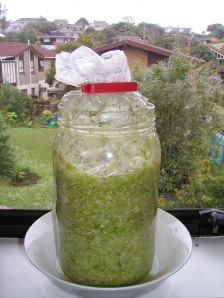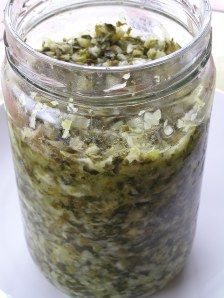This recipe has become a staple in our kitchen and pantry. Once made the sauerkraut will last for months. That’s what it originally was made for – to preserve the cabbage harvest over the winter months. With a little bit of help from the Lactobacillus acidophilus that lives naturally on cabbage. It turns the fermenting cabbage into a pro-biotic feast. Your intestines will love you for the support of friendly bacteria. In fact sauerkraut and other fermented cabbage products (more posts to come) have been a major part of our own rejuvenative diet. Ask your naturopath or colon therapist for their opinion on friendly bacteria from sauerkraut!
 Here we go with the culinary fun:
Here we go with the culinary fun:
Sauerkraut
makes about 3cups to 1liter
¨ 1 head cabbage, shredded finely
¨ 2 t natural sea salt
¨ ¼ cup minced fresh dill or 1 T dried
¨ 1 apple, peeled, cored and diced
- Massage the cabbage with the salt until the liquid starts to release.
- Let the cabbage rest for 10 minutes and massage it again. Repeat as often as necessary until the cabbage is very juicy. Add the remaining ingredients.
- Pack the mixture firmly into a large glass jar, crock, or bowl. Press the cabbage down until the liquid rises above it approximately 0.5cm.
- If you are using a large jar for your kraut, place a weight on top of the cabbage, such as a jar filled with water or a plastic bag filled with filtered water (see picture). Make sure to cover the jar with another plastic bag to keep any critters out. Place the jar in a bowl to catch any overflow of sauerkraut juice. collect the juice in a jar in your fridge and back to the finished kraut.

- Allow the kraut to ferment in your kitchen for at least 3 days (see note). We line the jars up in the window (no direct sun though).
- Once the kraut is ready, store it in airtight glass jars in the refrigerator. It will keep for several months.
Note: Kraut may be fermented for up to14 days, depending upon the desired degree of sourness.
Have fun experimenting with Sauerkraut! You can make variations with red cabbage, kale, add grated carrots, parsnips, broccoli etc.. It still is a great way to preserve a temporary over supply of vegetables.
 If you plan on adding any spicy foods like garlic or chilies to your sauerkraut wait till it is properly fermented. Garlic, chilies, ginger etc. are nature’s anti-biotics and will actually delay the fermentation process by inhibiting the lactobacillus acidophilus bacteria – for a while at least.
If you plan on adding any spicy foods like garlic or chilies to your sauerkraut wait till it is properly fermented. Garlic, chilies, ginger etc. are nature’s anti-biotics and will actually delay the fermentation process by inhibiting the lactobacillus acidophilus bacteria – for a while at least.
Other flavour options apart from dill are juniper berries and caraway (a spice I still hold some traumatic childhood memories of :-)).
Use your clean hands to massage the kraut! Go full out! Deep tissue, not Bowen 😉 The natural bacteria on your hands will be good for the fermentation process too. Just avoid those nasty alcohol-based desinfectants. ‘Dr. Bronners’ soaps will do – for a mild peppermint flavour in your Sauerkraut – just kidding.
The jar you see in the picture is a former olive or capers jar from our local deli. They hold 2 liters of anything (obviously :-)) and make great storage vessels for your pantry. We keep all of our nuts, seeds, spices, flour, crackers etc. in them.
Happy fermenting!


Pingback: Fermented Foods – a pro-biotic feast! | Raw Chef René on Vibrant Earth
Pingback: Almond Sauerkraut Bread – a convenient way to use almond pulp | Raw Chef René on Vibrant Earth
Pingback: Fermented Foods – nourishing traditions re-discovered | René Archner on Raw Food
Pingback: Water Kefir – explosive life force in a bottle | René Archner, Raw Food & More
Pingback: KimChi – more than pepped-up Sauerkraut! | René Archner Workshops, Food & More